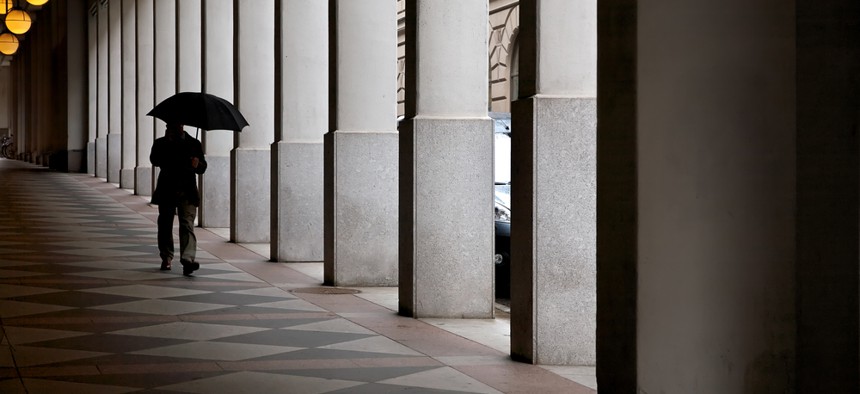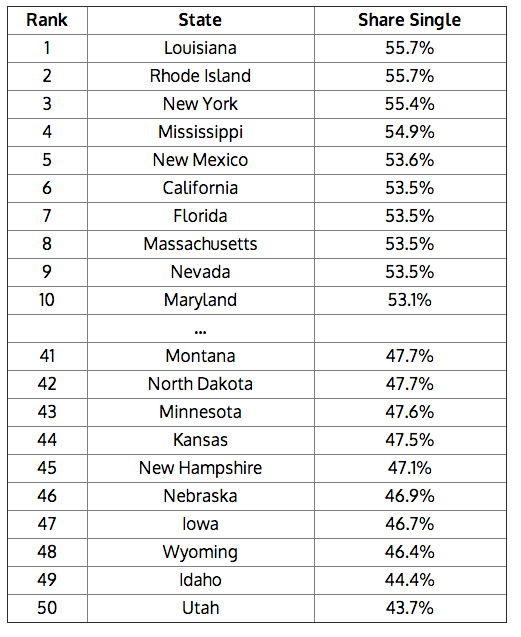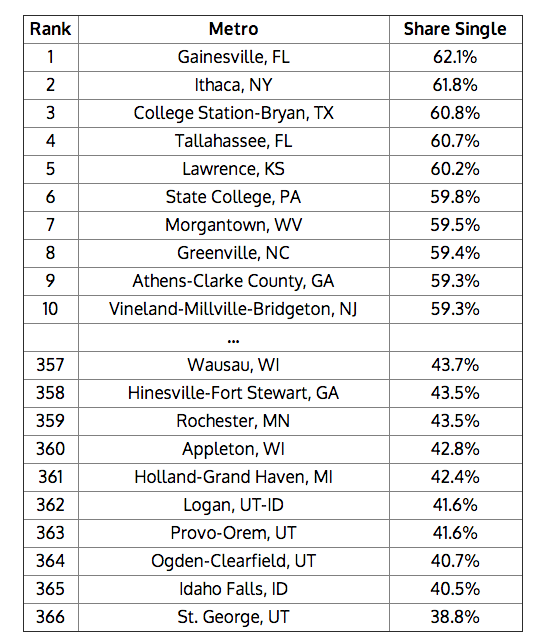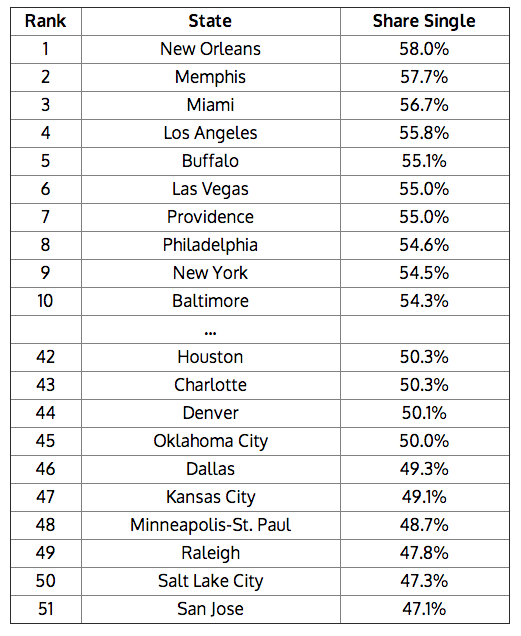Singles Now Make Up More Than Half the U.S. Adult Population. Here's Where They All Live

Valery Bareta/Shutterstock.com
The new geography of our "solo nation."
The United States is now a nation of singles. Single people make up just over half of all American adults for the first time since statistics have been collected, according to a study reported by Bloomberg last week.
But which states and metros have the highest and lowest shares of singles?
My Martin Prosperity Institute (MPI) colleague Charlotta Mellander crunched the U.S. Census figures on the share of American adults who are single, divorced or never married. According to these data, there were 128.2 million singles in the U.S. last year, or 51.2 percent of the population. These figures are similar to those in the study reported by Bloomberg, which was based on data from the U.S. Bureau of Labor Statistics and estimated that roughly 125 million Americans over the age of 16, or 50.2 percent, are currently single. That’s up from 37.6 percent in 1976.

Singles make up more than half of the population in 27 of the 50 states. And the share of single adults ranges from a low of 43.7 percent to a high of 55.7 percent, as the map above shows. The table below lists the top and bottom ten states.

Louisiana has the greatest share of single adults, followed by Rhode Island, New York, Mississippi, and New Mexico. California, Florida, Massachusetts, Nevada and Maryland round out the top 10. At the opposite side of the spectrum, the states where singles make up the smallest shares of the adult population include Utah, Idaho, Wyoming, Iowa and Nebraska.

Singles make up more than half of the population in more than six in ten of all U.S. metros (230 of 366). The share of single adults ranges from a low of 38.8 percent to a high of 62.1 percent, as the map above shows. The table below lists the top and bottom ten metros

College towns dominate the list of metros where singles make up the greatest share of the adult population. Topping the list is Gainesville, Florida (University of Florida), followed by Ithaca, New York (Cornell and Ithaca College), College Station, Texas (Texas A&M), Tallahassee, Florida (Florida State and Florida A&M), and Lawrence, Kansas (the University of Kansas). In those cities, singles make up more than 60 percent of the population. This is not surprising given the large number of younger students in these metros.
The metros where singles make up the smallest shares of the adult population include St. George, Ogden, Provo, and Logan, Utah; Holland, Michigan; and Appleton, Wisconsin.
Singles make up more than half the population in more than 46 of the 51 largest U.S. metros. The table below lists the large metros with the largest and smallest shares of singles.

New Orleans tops the list, followed by Memphis, Miami, Los Angeles, Buffalo, Las Vegas, Providence, Philadelphia, New York, and Baltimore. While the nation’s two biggest metros, New York and L.A., are on the list, Chicago fails to crack the top ten. And knowledge hubs, like San Francisco, Boston and Washington, D.C., known for attracting large numbers of highly educated young workers, also fall outside the top. This is likely because these places are home to and attracting younger people who fall in the prime years for getting married and forming families. The top ten is basically a mix of fast-growing Sun Belt metros and older Rust Belt metros with older populations, where widows and widowers likely make up larger shares of the single population.
At the opposite end of the spectrum, the large metros where singles make up the smallest share of adults are mainly faster-growing metros in the South and West, with younger populations overall and likely a bigger cohort of people in prime marriage and family-rearing age groups. The large metros where singles make up less than half of all adults include: San Jose, Salt Lake City, Raleigh, Minneapolis-St. Paul, Kansas City, and Dallas. The presence of San Jose (the hub of Silicon Valley), Denver, and Raleigh (in North Carolina’s Research Triangle) may come as something of a surprise. But again, these places are home to more younger people in their prime marrying years.
This is the new geography of our "solo nation” , in sociologist Eric Klinenberg’s coinage. If families prefer the suburbs for schools and safety, singles prefer denser urban neighborhoods with more to do and greater opportunities to meet and connect with other singles. Our changing demographic reality is an increasingly important component of the ongoing “great inversion” away from the suburbs and back to cities.
( Top image via Valery Bareta / Shutterstock.com )
NEXT STORY: Don't Worry About the Size of the Government





